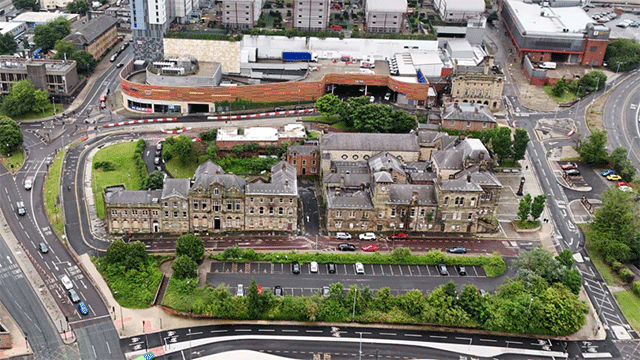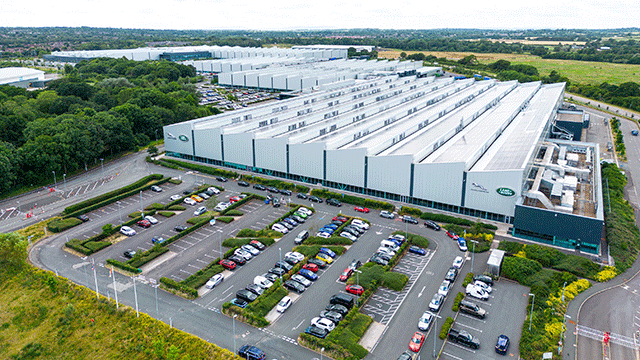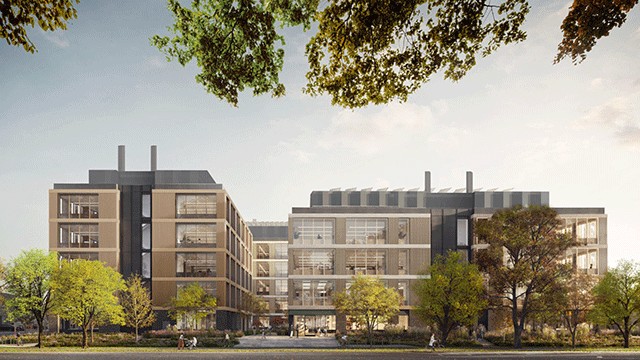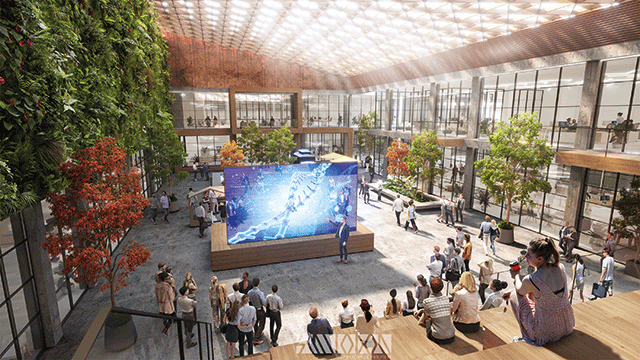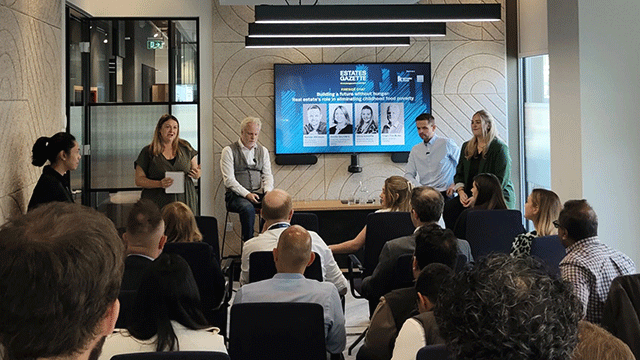Children are both today’s elbow-tugging distractions and the shoppers of tomorrow – no wonder centre owners are working harder to cater for their needs. But did they have to invent Kids City? By Elaine Knutt
Life as a parent can feel like signing up as an unwilling contestant in a game show called Keeping the Children Amused. Weekends and holidays are the battlegrounds, where points are awarded for novelty activities, food that’s fun and caters for faddy eaters, and just about anything that involves spending hard-earned cash. But be warned – points are deducted for every suggestion that scores a response of “boring”.
Shopping centres know that these family power-games can work for or against them. The trick is to harness the pester-power, while combating the “Can we go home now?” factor with a well-targeted retail and leisure offer.
“You have to keep the family group happy. Families who shop and eat together spend more than fixed-purpose shoppers. That’s why family appeal is at the top of every major landlord’s mind,” says Hugh Radford, head of shopping centres at CB Hillier Parker and a father of three.
Centres can mix’n’match two strategies to maximise their share of family disposable income. They can either treat children and parents as a single economic entity making shared purchasing decisions, or split family groups so that one or both parents are free to shop and browse untroubled by tantrums and toilet trips (see box opposite on Kids City).
To build a retail mix around children and parents, centres need to recognise children’s spending autonomy. It’s not just about pocket money: when research shows that a three-year-old can tell the difference between a Nokia mobile and an Ericsson, it’s clear kids are powerful brand advocates. “Children are influencing spending decisions on purchases of everything from hi-tech goods to cars, and that means retailers want them in their stores,” says Brenna O’Roarty, head of European retail research at Jones Lang LaSalle.
Going together, shopping apart
On the other hand, the strategy of regional centres with a leisure element is to divide families to double the spend. Neil Whitehead, director of architectural and “placemaking” consultancy ashleycarterwhitehead, adopted this approach on Belfast’s Odyssey Centre. “Teenagers and kids won’t make you money. They’re not economically active – you need to go where the disposable income is, and that’s the parents. Both groups need time to be themselves, to do their own thing, then come together for a meal.”
But shopping centres also have to consider a third issue: teenagers who wouldn’t be caught dead shopping with their parents, but who want to prove their independence by visiting centres with friends. And while the teens establish their identity, shopping centres need to establish themselves as environments where 12 to 16-year-olds are welcome to spend their allowances – but not to congregate in intimidating gangs.
Children’s limited interest in big ticket shopping has led Bluewater owner Lend Lease to reshape its offer at this most modern of UK centres.
When its market research found that children were the most common reason to cut short a shopping trip, Bluewater amended its retail mix to cater for children’s shorter attention spans: the offer is now intended to “grow” with its customer base. For the youngest to the early teens, it has a branded Lego “interactive” store, a Nestlé Kids Adventure Zone, and a Games Workshop. Tweenie girls have Claire’s Accessories and La Senza Girl; boys have several sports stores. Older girls can go for value fashion at Top Shop and H&M, while older boys can take their pick of brand labels.
Bluewater’s tenant mix also highlights the trend towards “interactivity” in child-centred retail. As well as Nestlé’s chocolate factory and La Senza Girl’s e-zine marketing, it has a branch of the Bear Factory – a spin-off from the toy shop Hamleys that has built up a chain of 31 branches since September 2000. Group marketing manager Delia Bourne describes it as “experience buying” rather than passive consumption. “It is interactive and hands-on: children have literally got a hand in making their own teddy.”
Not content with just Happy Meals
The food and drink offer is also an important aspect for families. According to Radford, many children have already had their fill of McDonald’s Happy Meals and prefer value family restaurants such as Nandos or TGIs. BDP designed the Tres Aguas centre in Madrid for Lend Lease, and, while it provides family-oriented restaurants, it also has a picnic area – a piece of pragmatism that trades the extra time spent at Tres Aguas for the forgone meal spend.
Picnic areas stem from the 21st-century thinking that says centres should blur the distinction between shopping and other activities. Such concepts lie behind Whitehead’s work at Belfast’s Odyssey, which aims to create a leisure destination that both children and parents consider a part of their lives. During the day, school trips fill the W5 interactive technology centre and Imax cinema. At evenings and weekends, families fill the bowling alleys and ice-hockey arena.
“It’s a modern, multi-functional shopping centre – the old ideas of what a shopping centre is for are breaking down,” says Whitehead. Of course, Odyssey’s approach is as much about commercial realities as community building: it treats families as being divided into fun-seeking kids and shopping mums and dads. “There’s high energy entertainment for the children, while the parents go shopping,” says Whitehead.
In South Africa’s Gateway Theatre of Shopping in Durban, Old Mutual Properties is using extreme sports to attract hard-to-reach teen consumers – then retail to the parents taxi-ing the kids to the venue.
It has developed a skating park and Wave House, a surfing pool with a powerful wave machine. Both host regular events and competitions, often to live nu-rock bands. Surf and skate brands have the nearest outlets to these facilities, but the entire centre benefits from increased traffic.
Whitehead’s placemaking consultancy is already working on extreme sports projects in the UK, which will see shopping centres make better use of external areas, and evolve into entertainment venues with far greater teenager and student appeal.
Striking a balance with teens
But not all teens are skate-heads or sport fanatics, and not all centres can be oriented to the outdoors. So what about the typical teen customer of tomorrow? Portuguese developer Sonae believes in making them welcome, and is happy for its cafés to be used as homework clubs. “Youngsters are our customers too,” says Ted Kupchevsky, director for Sonae’s German operations. “We can fulfil a general social need that city centres no longer meet.”
Hammerson director of retail asset management Vanessa Forster says a tricky balance must be struck. “We have neither a negative nor a positive policy towards teenagers,” she explains. “They have money to spend, and the tenant mix is there for them too. But sometimes, security has to gently remind them that they’re in a public place.”
CB Hillier Parker’s Radford agrees, but suggests that centres could learn from brands on how to build loyalty among teenagers using e-mail or text marketing techniques.
Centres have to build their relationship with tomorrow’s consumers, he says. “The trick is to make it as easy as possible to shop with kids,” says Radford. “Families who plan their day around what a centre has to offer spend more, so centres need to make that possible.” And as a father of a two tweenies and a five-year-old, he should know.
|
Mall mice take over Mexico – and then the world |
|
There is a suburb of Mexico City where children drive General Motors cars hired from Hertz, and fill Wal-Mart shopping trolleys with familiar brands. If their spending spree goes over budget, they can earn extra “pesitos” flipping burgers at Burger King. After a one-hour shift, they can catch up with the exploits of the undersized police force, fire brigade and hospital ER team via reports on their own television station. This is Kids City, where four to 12-year-olds who can’t wait to grow up can get a sneak preview of adult life. In 54 different pavilions, each sponsored by a Mexican or multinational brand, visitors can unleash their imaginations on role-play scenarios that are updated regularly by adult staff. To encourage multiple visits, kids can open an account to bank unspent pesitos for the next visit. But Kids City’s other financial coup is its booster effect on the full-sized Santa Fe shopping mall next door. By separating parents from the shorter attention spans of their children, Kids City also helps to separate the adults from their real-life pesos. “We originally wanted a standalone site, but now we see benefits of being next to a shopping centre,” says Miguel Luna, chief concept officer of Kids City International, who sees the concept spreading round the world. Kids City activities combine interactivity with the children’s favourite of a take-home present. The little visitors can mix their own perfume, design their own jewellery or develop their own photos on the Kodak machine. Vocational choices include scientist, beautician, bus driver, chef or lawyer. However, parents won’t be surprised by the most popular activity – a tour of the sewage system. For brands, it is also an example of “experiential marketing”. When media-savvy children tune out conventional advertising, the brand has to be slipped into their lives in other ways. “We partner with leading brands in each sector, and take good care of them,” says Luna. Fifty are on the waiting list, including Warner and Federal Express. Kids Cities are in development in New York and Las Vegas, and the first European version will open in spring 2005, in Madrid, where Kids City is to be a rent-paying tenant in Riofisa’s Plenilunio shopping centre near Barajas airport. “We do not have the resources to make capital investments – we can rent or we can partner,” says Luna. Such partnering is one of the advantages of shopping centre co-location, he adds, since there are good cost savings on shared services, with each pavilion having a heavy services load. Construction costs at Madrid are estimated at €15m, part of which is met by brand sponsorship fees. For future expansion, Kids City is looking for cities with a high catchment of children. The location should be a regional destination in its own right, draw visitors from a wide radius, and have good transport connections. Sites need good access and visibility, a footprint of between 4,000m2 and 10,000m2, preferably with a regular shape and a floor-to-ceiling height of 12m that allows room for the creation of a junior city, with its own cleverly mocked-up “skyline”. Although the concept might seem to be more at home in a theme park, Luna is confident that the shopping centre argument stacks up. “There’s a high frequency of repeat visits, just like shopping centres. The combination suits the whole family.” |





